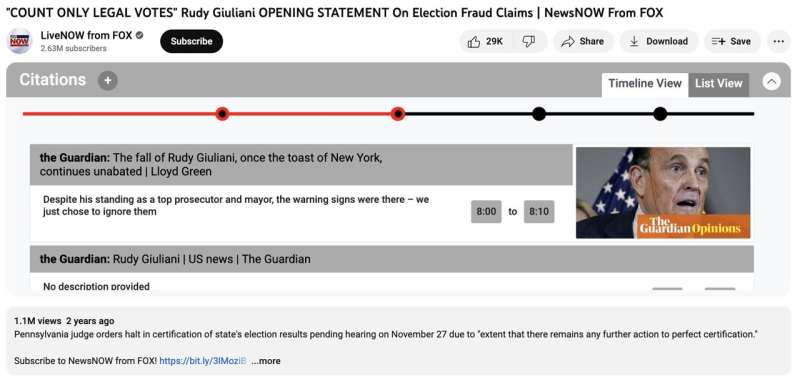
While Google has long been synonymous with search, people are increasingly seeking information directly through video platforms such as YouTube. Videos can be dense with information: text, audio, and image after image. Yet, each of these layers presents a potential source of error or deceit. When people search for videos directly on a site like YouTube, sussing out which videos are credible sources can be tricky.
To help people vet videos, the University of Washington researchers created and tested Viblio, a browser extension that lets viewers and creators add Wikipedia-like citations to YouTube videos. The prototype offers users an alternate timeline, studded with notes and links to sources that support, refute, or expand on the information presented in the video.
Those links also appear in a list view, like the "References" section at the end of Wikipedia articles. In tests, 12 participants found the tool useful for gauging the credibility of videos on topics ranging from biology to political news to COVID-19 vaccines.
The team will present its findings on May 14 in Honolulu at the ACM CHI Conference on Human Factors in Computing Systems. The paper is also available on the arXiv preprint server. Viblio is not yet available to the public.
"We wanted to come up with a method to encourage people watching videos to do what's called 'lateral reading," which is that you go look at other places on the web to establish whether something is credible or true, as opposed to diving deep into the thing itself," said senior author Amy X. Zhang, an assistant professor in the Paul G. Allen School of Computer Science & Engineering.
"In previous research, I'd worked with the people at X's Community Notes and with Wikipedia and seen that crowdsourcing citations and judgments can be a useful way to call out misinformation on platforms."
To inform Viblio's design, the team studied how 12 participants—mostly college students under 30—gauged the credibility of YouTube videos when searching for them on the platform and while watching them. All said, familiarity with the video's source and the name of the channel was important. But many cited signs of a video's potentially faulty credibility: the quality of the video, the user's degree of interest in it, its ranking in search results, its length and the number of views or subscribers.
The team also found that in one case, a participant misinterpreted a YouTube information panel as an endorsement of the video from the Centers for Disease Control and Prevention. But these panels are actually links to supplemental information that the site attaches to videos on "topics prone to misinformation."
"The trouble is that a lot of YouTube videos, especially more educational ones, don't offer a great way for people to prove they're presenting good information," said Emelia Hughes, a doctoral student at the University of Notre Dame who completed this research as a UW undergraduate student in the Information School.
"I've stumbled across a couple of YouTubers who were coming up with their own ways to cite sources within videos. There's also not a great way to fight bad information. People can report a whole video, but that's a pretty extreme measure when someone makes one or two mistakes."
The researchers designed Viblio so users can better understand videos' content while also avoiding things like users misinterpreting the additional information. To add a citation, users click a button on the extension. They can then add a link, select the timespan for their citation references, and add optional comments.
They can also select the type of citation, which is marked with a colored dot in the timeline: "refutes the video clip's claim" (red), "supports the video clip's claim" (green), or "provides further explanation" (blue dot).
To test the system, the team had the study participants use Viblio for two weeks on a range of videos, including clips from Good Morning America, Fox News, and ASAPScience. Participants could add citations as well as watch videos with other participants' citations. For many, the added citations changed their opinion of certain videos' credibility.
But the participants also highlighted potential difficulties with deploying Viblio at a larger scale, such as the conflicts that arise in highly political videos or those on controversial topics that don't fall into true-false binaries.
"What happens when people with different value systems add conflicting citations?" said co-author Tanu Mitra, a UW assistant professor in the Information School. "We, of course, have the issue with bad actors potentially adding misinformation and incorrect citations, but even when the users are acting in good faith but have conflicting options, whose citation should be prioritized? Or should we be showing both conflicting citations? These are big challenges at scale."
The researchers highlight a few areas for further studies, such as expanding Viblio to other video platforms such as TikTok or Instagram, studying its useability at a greater scale to see whether users are motivated enough to continue adding citations and exploring ways to create citations for videos that don't get as much traffic and thus have fewer citations.
"Once we get past this initial question of how to add citations to videos, then the community vetting question remains very challenging," Zhang said. "It can work. At X, Community Notes is working on ways to prevent people from 'gaming' voting by looking at whether someone always takes the same political side. And Wikipedia has standards for what should be considered a good citation. So it's possible. It just takes resources."
More information: Emelia Hughes et al, Viblio: Introducing Credibility Signals and Citations to Video-Sharing Platforms, arXiv (2024). DOI: 10.48550/arxiv.2402.17218
Journal information: arXiv
Citation: Prototype browser extension adds Wikipedia-like citations on YouTube to curb misinformation (2024, May 9) retrieved 9 May 2024 from https://techxplore.com/news/2024-05-prototype-browser-extension-wikipedia-citations.html
This document is subject to copyright. Apart from any fair dealing for the purpose of private study or research, no part may be reproduced without the written permission. The content is provided for information purposes only.
